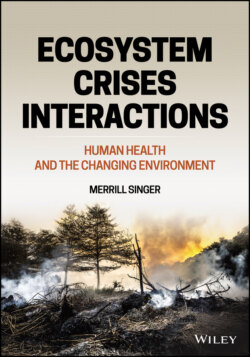Читать книгу Ecosystem Crises Interactions - Merrill Singer - Страница 44
2.3.4 Human‐dominated ecosystems
ОглавлениеAll organisms, past and present, modify their ecosystems, and “studies on lakes, coral reefs, oceans, forests and arid lands have shown that smooth [environmental] change can be interrupted by sudden drastic switches to a contrasting state” (Scheffer et al. 2001). In the case of humans, however, the extent of ecosystem alteration can be both rapid and far‐reaching (Fig. 2.4). At the local or regional scale, human‐dominated ecosystems include agricultural fields, created and maintained pasturelands, planted forests, urban areas, populated islands, and similar settings where the effects of human presence are sweeping. It is even possible to talk of all of Earth as a human‐dominated ecosystem, as there are no terrestrial ecosystems and almost none underwater that are untouched by human activity (Vitousek et al. 1997). When humans clear lands for agriculture, send airplanes across the skies, fish the oceans, operate manufacturing plants, or produce and use cement, we reconfigure the major biogeochemical cycles of Earth, including those of CO2, nitrogen, and sulfur.
The concentration of CO2 in the atmosphere has steadily increased as a result of human activities, especially since the Industrial Revolution, but starting long before that with alterations like clearing and planting. Even indigenous populations cleared forested areas through burning to increase grassy pastures in which to find and hunt grazing wild animals. Human alterations of the hydrological cycle can change regional weather patterns and even longer‐term climate. Implementing irrigation systems raises atmospheric humidity in semiarid locations, which promotes the frequency of rain and thunder storms. Humans have also altered the global nitrogen cycle. A vital biosynthesizing element for living organisms, nitrogen is present in abundance in the atmosphere but must be combined with carbon, hydrogen, or oxygen to form ammonia or other molecules in order to be useable by most lifeforms, a process known as fixation. Human activity has substantially altered the global nitrogen cycle through both fertilizer production and fossil fuel combustion. The global sulfur cycle, meanwhile, has been changed by the acquisition and burning of fossil fuels. Unprecedented increases in the amount of sulfur in both the atmosphere and the oceans is now occurring. Sulfur dioxide emitted by the fossil fuel industry reacts with water vapor in the atmosphere to form acid rain, which is damaging to forests, fish, and other aquatic animals. Oceans, too, feel the impact of acid rain, especially in coastal areas, which are becoming more acidic and being stripped of the carbonate ions needed by shell‐making sea life. The ability of human technologies to change multiple biogeochemical cycles in these ways creates the potential for radical alterations of Earth.
Fig. 2.4 Human alteration of key components of Earth ecosystems.
Source: Modified from Vitousek et al. (1997).
